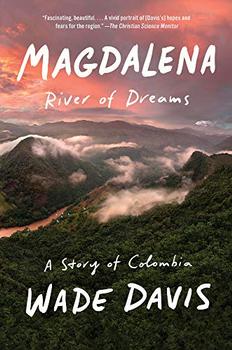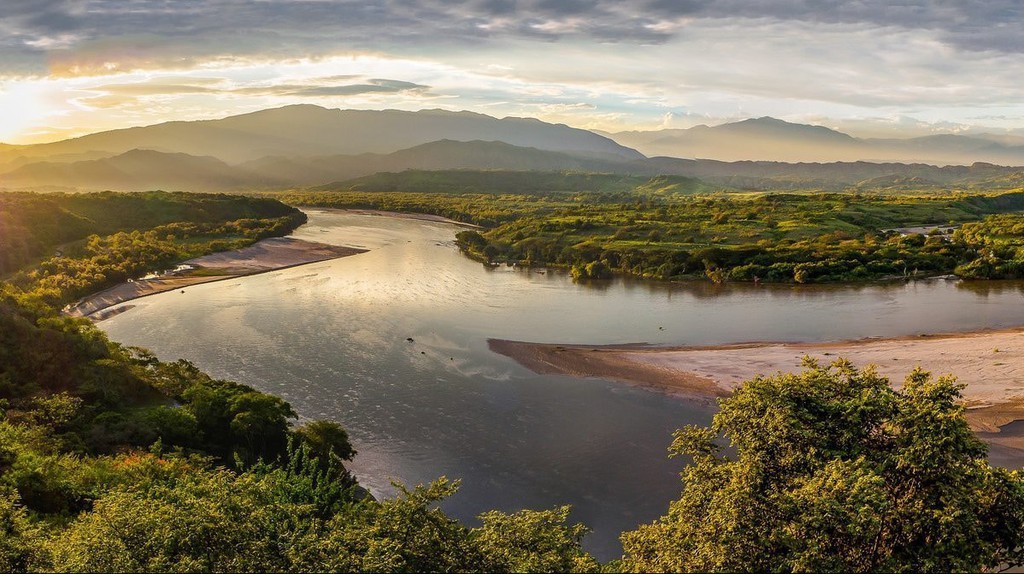Summary | Excerpt | Reviews | Beyond the Book | Read-Alikes | Genres & Themes | Author Bio

River of Dreams: A Story of Colombia
by Wade DavisThis article relates to Magdalena
 Colombia is a nation with a supremely rich diversity of natural wonders. Its geography alone encompasses a dizzying array of ecosystems, such as coastal deserts, wetlands, dense tropical forests, verdant valleys and snowy mountain tops. But perhaps most impressive is the biological and botanical abundance of this South American country. According to the World Wildlife Fund, Colombia is the second most biodiverse country in the world, closely following Brazil. Furthermore, they note that "per square kilometer, it is the most biodiverse country, with more bird, amphibian, butterfly, and frog species … than anywhere else in the world."
Colombia is a nation with a supremely rich diversity of natural wonders. Its geography alone encompasses a dizzying array of ecosystems, such as coastal deserts, wetlands, dense tropical forests, verdant valleys and snowy mountain tops. But perhaps most impressive is the biological and botanical abundance of this South American country. According to the World Wildlife Fund, Colombia is the second most biodiverse country in the world, closely following Brazil. Furthermore, they note that "per square kilometer, it is the most biodiverse country, with more bird, amphibian, butterfly, and frog species … than anywhere else in the world."
The source of Colombia's stunning diversity of animals and fauna is its unique location in South America along the equator with coastlines on both the Atlantic and Pacific Oceans and three mountain systems. The country features a variety of climates and ecosystems and is naturally split into five distinct regions: Andes, Pacific, Caribbean, Amazon and the Llanos (plains). It is this varying topography that accounts for 51,330 species registered in the country, with more than 1,920 bird species, 528 types of mammals and 1,521 species of fish, according to the 2019 Biodiversity Information System in Colombia.
Conservation is a necessary part of maintaining the ecosystem for this and future generations. When humans interact with their ecosystem, it's often the ecosystem that loses something not easily regained. In the case of Colombia, people damage the ecosystem by altering land for agricultural purposes. According to the Convention on Biological Diversity, it's estimated "that almost 95% of the country's dry forests have been reduced from their original cover, including close to 70% of typically Andean forests." While this is sobering, there are many active measures Colombia is taking to protect its precious organic resources.
Protecting water sources is a key endeavor for conservation groups, both local and global. The Nature Conservancy (TNC), a global environmental nonprofit association active in 79 countries and territories across six continents, has identified "rampant agricultural fields and cattle ranching" as factors that threaten pristine forests, which are necessary for natural water purification. Trees act like natural sponges, cleaning rainfall and filtering out pollutants before releasing the water slowly back into rivers and streams.
Rather than seeking costly industrial filtration solutions, TNC advocates for a more holistic approach to keeping Colombia's water sources clean. Providing financial assistance to upstream landowners who use "sustainable farming practices and conserve/restore natural areas," ensures water is safeguarded as it moves on its way to supply Colombian cities.
Colombia is a breathtakingly beautiful and bountiful country, drawing more tourists every year. Its biological and ecological wonders are a source of pride for residents, and the need to conserve and preserve its natural treasures is increasingly urgent.
Magdalena River, courtesy of The Culture Trip
Filed under Nature and the Environment
![]() This "beyond the book article" relates to Magdalena. It originally ran in September 2020 and has been updated for the
June 2021 paperback edition.
Go to magazine.
This "beyond the book article" relates to Magdalena. It originally ran in September 2020 and has been updated for the
June 2021 paperback edition.
Go to magazine.
At times, our own light goes out, and is rekindled by a spark from another person.
Click Here to find out who said this, as well as discovering other famous literary quotes!
Your guide toexceptional books
BookBrowse seeks out and recommends the best in contemporary fiction and nonfiction—books that not only engage and entertain but also deepen our understanding of ourselves and the world around us.